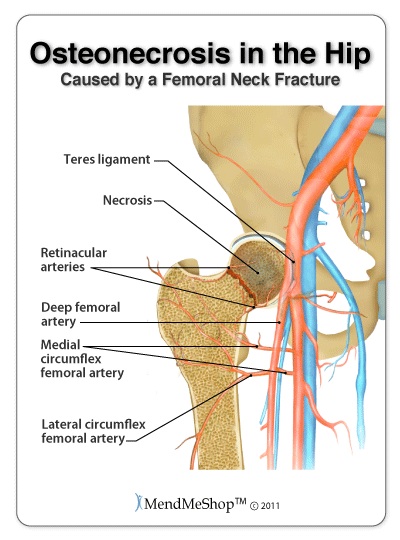Hip necrosis, also called osteonecrosis or avascular necrosis, is a painful condition in which lack of proper blood flow to the head of the femur results in osteocytes and the bone marrow dying. This weakens the bone and can lead to a collapse of the femur head and eventual arthritis as the surface of the femur head (articular cartilage) changes shape.

The teres ligament connects the top of the femoral head to the tissue inside the acetabular joint and contains a small artery that supplies blood to the femoral head. The lateral and medial circumflex femoral arteries branch off the femoral artery and supply the femoral head with the majority of its blood supply. The femoral artery is a large blood supplier that starts in the pelvis and travels down the leg to the inside of the knee.
If the blood supply is not steady enough to keep the femoral head healthy, osteonecrosis can set in. Blood supply to the femoral head may be affected if there is a fracture in the neck of the femoral neck or a tear in the teres ligament
A patient suffering from hip osteonecrosis will typically exhibit one or more of the following symptoms..
To make a diagnosis, your doctor may take an x-ray to rule out a fracture (as this is often the cause of limited blood flow to the femoral head). An MRI will be the best tool to determine the state of the cartilage and other soft tissue in the hip joint. A bone scan or CT scan could also be used to help with the diagnosis.
Trauma to the hip joint (i.e. fracture or dislocation) can interrupt the flow of blood to the femoral head, leading to osteonecrosis. In some cases, osteonecrosis can occur with no obvious reason, however, some conditions and indicators appear to put some people at greater risk:
Diagnosing osteonecrosis early will allow for the cause of the limited blood flow to be corrected and treated, reducing the amount of bone damage done. For any chronic condition that may cause hip necrosis or once the arteries are repaired, improving blood flow to the hip joint is essential to prevent any further bone marrow from dying and improving the health of the hip joint.

There are two surgical treatments for the early stages of osteonecrosis. The first is hip decompression where they drill holes in the area of the hip osteonecrosis to help relieve the pressure on the femoral head.
The other treatment is to do a vascularized bone graft. In this procedure, healthy bone and blood vessels are taken from another part of the leg and moved to the area affected by osteonecrosis.
If the osteonecrosis has progressed into later stages, treatment is typically limited to either (1) a total hip replacement or (2) a hip resurfacing surgery . The goal of a hip replacement is to restore function and mobility to the hip with artificial parts. This is a good option, as it solves the problem long term and most people with artificial hips live active, healthy lives after their surgery.
Much like a hip fracture or a hip dislocation, hip osteonecrosis is a serious medical emergency! Immediate treatment is necessary, so get to the hospital quickly.
With a osteonecrosis, it is pretty much a given that you will be undergoing surgery. Significant secondary damage will probably have occurred from the fracture, including complications to nearby nerves, blood vessels and protective cartilage in the joint. Most probably, the ligaments surrounding the hip joint will have been damaged - perhaps strained or even ruptured. All of these issues will determine the length of your rehabilitation. In some cases, damage to blood vessels near the hip joint can cause a loss of blood supply to the bone - this is known as osteonecrosis.
In nearly all cases of recovery, your physician, physical therapist or surgeon will recommend a treatment recovery plan for you that will include Rest, Ice, Compression, Elevation, Stretching - basically an outline of conservative treatments. Protocols used in recovery from a hip fracture are basically the same protocols found in hip post surgery recovery. To view more information about post operative recovery/rehabilitation of the hip, click here.
We've helped thousands of people treat their painful injuries and conditions to get them back on the road to a pain-free life!
Click HERE to Go To Our Online Store We take all major credit cards and Paypal.
If you have questions, call our office at 1-866-237-9608 (toll free continental US).
We are currently offering FREE SHIPPING and a 60 day trial period on all our Wraps.
Product Advisors are available 9:00 am to 5:00 pm Eastern Standard Time Monday to Friday.
I want to learn more about Hip Surgery & Post-Surgery Recovery
I want to learn more about Circulation Boost
I want to learn more about Ice & Heat: Which Is Better For The Hip?
I want to learn more about Trigger Points in the Hip
I want to learn more about Hip Surgery: Do I Need It?
During your recovery, you will probably have to modify and/or eliminate any activities that cause pain or discomfort at the location of your soft tissue injury until the pain and inflammation settle. The more diligent you are with your treatment and rehabilitation, the faster you will see successful results!
Please be aware that this information is neither intended nor implied to be a substitute for professional medical advice. CALL YOUR HEALTHCARE PROVIDER IMMEDIATELY IF YOU THINK YOU MAY HAVE A MEDICAL EMERGENCY. Always seek the advice of your physician or other qualified health provider before using any of our outstanding products to make sure they are right for you and your condition or if you have any questions regarding a medical condition. Always see your doctor for a proper diagnosis as there are often many injuries and conditions (some very serious) that could be the cause of your pain.
© 2025 In.Genu Design Group, Inc. Contact Us